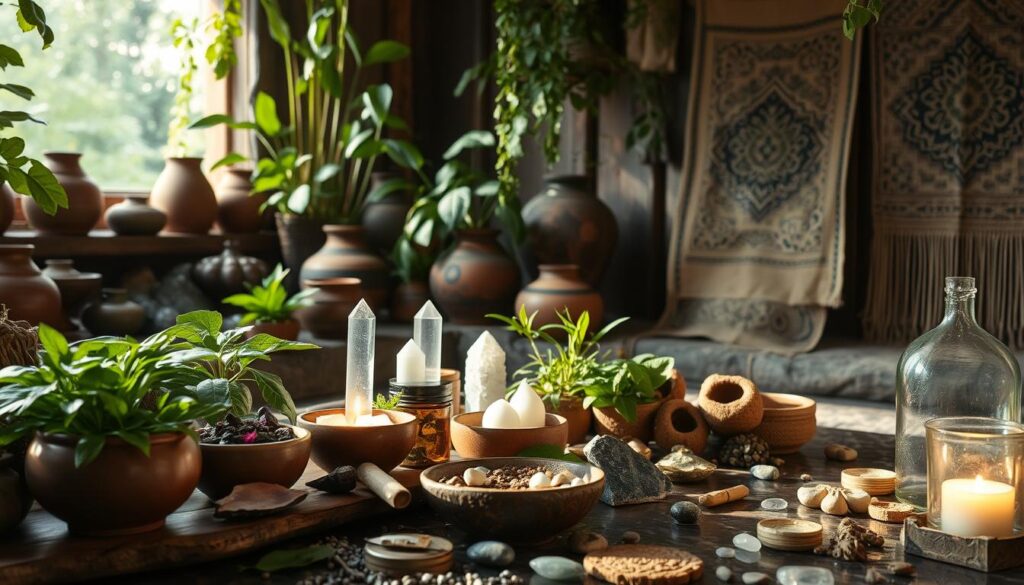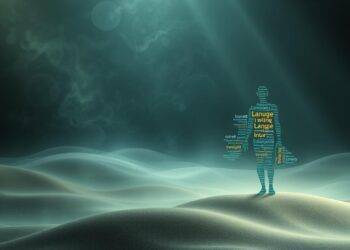Albert Einstein once said, “The more I learn, the more I realize how much I don’t know.” This is especially true when we look at ancient healing practices. For thousands of years, people have used nature, spirituality, and holistic methods to stay healthy. These old ways, like shamanic rituals and Hippocratic medicine, still shape today’s healthcare.
Now, ancient healing methods are being used alongside modern medicine. Things like acupuncture, herbal remedies, and meditation are seen as helpful. But, keeping these old practices alive is hard today. We face issues like money problems, cultural views, and rules that get in the way.
Key Takeaways
- Ancient healing practices have survived for millennia, offering insights into holistic approaches to health and wellness.
- Traditional medicine is being integrated into mainstream healthcare, with practices like acupuncture and herbal remedies gaining scientific validation.
- Preserving and revitalizing these ancient traditions face challenges in the modern world, including sociocultural and regulatory barriers.
- The integration of traditional and modern healing systems holds the potential to transform healthcare, drawing upon the wisdom of the past and the advancements of the present.
- Exploring the science behind ancient healing practices can unlock new frontiers in medicine, providing a comprehensive understanding of the human experience.
Understanding the Origins of Traditional Medicine
Traditional medicine has deep roots, going back thousands of years. It’s tied to the spiritual and cultural practices of ancient civilizations. Shamanism, one of the oldest healing forms, dates back tens of thousands of years. Shamans used rituals, herbs, and spiritual connection to heal.
Ancient medical systems like Egyptian healing were linked to religion and magic. Priests were healers. The Ebers Papyrus, from 1550 BCE, shows ancient Egypt’s vast medical knowledge. Ayurveda, from ancient India, focuses on the balance of mind, body, and spirit.
Early Evidence of Healing Practices
Early civilizations worldwide developed advanced ancient medical systems. These were often tied to religious beliefs. In ancient Greece, Hippocrates and Galen made big strides in medicine. They emphasized observing nature and understanding disease.
Cultural Development of Ancient Medical Systems
The cultural development of ancient medical systems was shaped by each civilization’s worldview. For example, Traditional Chinese Medicine (TCM) is based on yin and yang, qi, and the connection of all things.
The Role of Spiritual Beliefs in Healing
In many ancient traditions, spiritual beliefs were key in healing. Shamans, priests, and healers were seen as bridges. They used rituals, herbs, and spiritual connections to heal body and mind.
| Ancient Healing Practices | Key Characteristics |
|---|---|
| Shamanism | Spiritual intermediaries, rituals, herbal remedies, and connection to the spiritual realm |
| Egyptian Healing | Deeply connected to religion and magic, priests as healers, the Ebers Papyrus |
| Ayurveda | Holistic approach, mind-body-spirit balance, ancient Indian healthcare system |
| Greek Medicine | Emphasis on rational observation and naturalistic explanations, Hippocrates and Galen |
These ancient indigenous knowledge and ancient wisdom systems are the base of many modern wellness practices and healthcare advances. They show the great value of traditional medicine.

The Science Behind Ancient Healing Practices
Modern medicine keeps growing, and scientists are finding out how ancient holistic health and alternative therapies work. About 40% of today’s medicines come from nature and old natural remedies.
Drugs like aspirin and treatments for childhood cancer come from ancient medicine. Tu Youyou won a Nobel Prize for her work on artemisinin for malaria, based on Chinese medicine. Aspirin, from willow bark, has helped with pain and swelling for over 3,500 years.
Many natural compounds have led to big medical wins. The Madagascar periwinkle, hawthorn, foxglove, star anise, and wild Mexican yam have helped fight cancer, heart disease, and birth control.
“Traditional medicine has been used for at least 2500 years, while modern medicine has only been dominant for about 100 years. The scientific validation of ancient healing practices is a testament to the timeless wisdom embedded in these traditions.”
As scientists learn more about these natural remedies, old and new medicine are coming together. This mix promises a better, more complete healthcare approach. It combines ancient knowledge with modern science.

Traditional Chinese Medicine and Modern Scientific Validation
Traditional Chinese Medicine (TCM) is getting more attention in energy healing, holistic health, and alternative therapies. It’s blending with today’s healthcare, and scientists are studying it. They want to understand how it works and if it’s scientifically valid.
Acupuncture’s Neurological Effects
Acupuncture, a big part of TCM, has been studied a lot. It’s found to change the brain, affecting pain and other body functions. For example, it helps with chronic lower back pain, a big problem for many.
Herbal Medicine Research
Herbal medicine in TCM is also getting a lot of research. Scientists are looking into how herbs can help in healthcare today. They’ve found some herbs that might help with energy healing, holistic health, and new treatments.
Integration with Contemporary Healthcare
TCM is slowly becoming part of today’s healthcare. Doctors and researchers are working together. They’re trying to use the best of both worlds. This way, patients get a more complete and personal care that fits TCM’s holistic views and modern medicine’s evidence.
“The integration of Traditional Chinese Medicine and modern scientific validation is a fascinating journey, where ancient wisdom and cutting-edge research converge to unlock new frontiers in holistic health and alternative therapies.”
Ayurvedic Medicine: Ancient Indian Healthcare System
Ayurveda is India’s healthcare system with roots over 3,000 years old. It focuses on the balance between mind, body, and spirit. The ancient texts like the Charaka Samhita and Sushruta Samhita guide it. They cover diagnosis, treatment, and prevention, including herbal remedies and dietary advice.
Recent studies have shown that Ayurvedic wellness practices work. For example, turmeric’s anti-inflammatory effects have been confirmed. Today, Ayurveda is being used more in healthcare, especially in prevention and lifestyle management.
| Ayurvedic Medicine Statistics | Data |
|---|---|
| Registered Ayurvedic Practitioners in India | 250,000 |
| Practitioners of Modern Medicine in India | 700,000 |
| Medicinal Plants Used in Traditional Indian Medicine | 7,000-7,500 |
| Traditional Practitioners Using Medicinal Systems in India | Over 1.5 million |
| Herbals Sold as Dietary Supplements in India | Over 1,500 |
In the U.S., Ayurvedic medicines are seen as dietary supplements, not drugs. They might contain harmful substances like lead and mercury. So, it’s wise to talk to a doctor before trying Ayurvedic treatments, especially if you’re pregnant or have health issues.
“Ayurveda is complementary to standard medical care and should not replace it, especially for serious health conditions or in high-risk groups.”
The holistic nature of Ayurveda is attracting more attention in today’s healthcare world. It’s all about finding balance in mind, body, and spirit.
Shamanic Healing Traditions and Psychology
Shamanic practices have a deep connection to the mind-body relationship. These ancient traditions use altered states of consciousness. Now, they are gaining interest and scientific backing in modern psychology.
Shamanic rituals use drumming, chanting, or plant medicines to create altered states. These experiences are being studied for treating mental health issues like trauma and depression.
Exploring the Neurochemistry of Plant Medicine
Plant medicines, like ayahuasca, are being studied for their effects on the brain. Researchers are looking into their therapeutic benefits. They might unlock new ways to treat mental health.
Integrating Shamanic Principles into Modern Therapy
Modern therapists are adding shamanic healing to their work, especially for trauma and addiction. They use ancient wisdom to support the mind-body connection. This leads to deep personal changes.
As we mix energy healing, indigenous knowledge, and psychology, we gain deeper insights. By combining old wisdom with new science, we may find new paths to wellness and mental health.
Natural Compounds in Modern Drug Development
The search for natural remedies has always driven the creation of new medicines. Many modern drugs come from ancient alternative therapies and holistic health practices.
For example, artemisinin, a key malaria drug, comes from sweet wormwood in traditional Chinese medicine. Vinblastine and vincristine, used in chemotherapy, were found in the Madagascar periwinkle. This plant has a long history in holistic health.
Drug discovery often starts with studying how plants and natural substances are used. Then, scientists isolate and modify their active parts. This method, called ethnopharmacology, is still a key way to find new drugs.
“Natural products have been a source of inspiration for organic chemists to synthesize novel drug candidates.”
New technologies like better analytical tools and genome mining are making natural products interesting again. Researchers are looking at the unique qualities and chemical variety of these substances. They often find things different from what combinatorial chemistry can create.
The ongoing search for natural remedies and alternative therapies is exciting. Mixing old knowledge with new science could lead to big advances in holistic health and drug making.
Mind-Body Connection: Ancient Practices in Contemporary Wellness
The mind and body are deeply connected, a fact known for centuries. Modern science is now proving how ancient wellness practices can boost our health. These practices can improve both our physical and mental health.
Meditation and Brain Function
A 2023 study used brain imaging to show the mind-body link. It found that meditation changes the brain. This can lead to better focus, emotional control, and stress handling.
Yoga’s Impact on Physical and Mental Health
Yoga combines physical poses, breathing, and meditation. It’s been shown to improve physical health and mental well-being. Regular yoga can increase flexibility, strength, and balance. It also lowers stress and boosts mood.
Stress Reduction Techniques
The mind-body connection is key in managing stress. Chronic stress weakens the immune system and causes inflammation. This can lead to serious health problems. Techniques like deep breathing, mindfulness, and exercise can reduce stress and improve wellness.
As we learn more about the mind-body connection, ancient practices like meditation and yoga are becoming part of modern healthcare. They help with conditions like chronic pain, anxiety, and depression. By using these holistic methods, we can achieve a more balanced and fulfilling life.
“Managing thoughts and training the mind can lead to less stress and anger, promoting healthier habits and improving overall quality of life.”
Indigenous Knowledge and Biodiversity Conservation
For centuries, local communities have used medicinal plants and traditional healing. This knowledge helps preserve biodiversity. It’s now seen as key in finding new medicines and saving plants.
Indigenous groups worldwide manage ecosystems well. In Namibia, the Himba use traditional knowledge for water. In Southern Africa, the San know a lot about plants and medicine. In the Amazon, the Kayapo protect the rainforest.
But, using this knowledge in conservation is hard. There’s a risk of losing it, and it’s often not valued by policymakers. Also, there are legal issues with land rights. We need to overcome these to use traditional knowledge for the environment.
| Key Benefits of Indigenous Knowledge in Environmental Conservation |
|---|
|
Combining indigenous knowledge with science can lead to big wins. Plants like Curcuma longa (turmeric), Azadirachta indica (neem), and Panax ginseng (ginseng) are now used worldwide. By saving this knowledge, we can tackle big environmental and health issues.
Technology and Traditional Medicine Integration
In healthcare, modern tech and old healing ways are coming together. This mix is leading to big steps forward in treatments and health care. Scientists are learning a lot from traditional medicine, changing how we see health care.
Artificial intelligence (AI) is a big part of this change. It looks through huge amounts of traditional medical data. This helps find new uses and patterns that were hard to see before. It’s opening up new areas in health care.
Imaging tech like fMRI is also key. It shows how practices like meditation and acupuncture affect our brains. This helps us understand how these old healing ways work. It’s making health care more effective and tailored to each person.
Also, new ways to study traditional herbs are leading to new medicines. This is making holistic health a bigger part of regular health care. It gives patients a more complete and personal way to take care of their health.
“The mix of old medicine and new tech is very promising for health care. It’s unlocking secrets of old healing and using the latest science.”
The future of health care is about mixing old and new ways. This creates a more complete and personal way to care for our health. By combining these, we can make health better for people everywhere.
| Statistic | Percentage |
|---|---|
| Use of traditional and complementary medicine in the United States | 42% |
| Use of traditional and complementary medicine in Australia | 48% |
| Use of traditional and complementary medicine in France | 49% |
| Use of traditional and complementary medicine in Canada | 70% |
| Use of traditional and complementary medicine in Chile | 71% |
| Use of traditional and complementary medicine in Colombia | 40% |
The mix of old and new in health care is making it better. By using the latest science and old healing ways, we’re finding new ways to be healthy. This is a big step forward in health care.
Conclusion
Combining ancient healing practices with modern science is showing us new ways to treat diseases. There are still hurdles to overcome to make these traditional methods part of today’s healthcare. Yet, more people see the value they bring to holistic health.
The future of health care might be a mix of old wisdom and new science. This could lead to treatments that are more tailored to each person’s needs. As you delve into this exciting field, keep an eye out for breakthroughs that could change how we care for ourselves and others.
You have a chance to help create a future where old and new medicine work together. This could open up new paths to better health and well-being for everyone.
FAQ
What is the history of ancient healing practices?
For thousands of years, ancient healing practices have been a big part of human life. They go back to shamanic rituals and Hippocratic medicine. These old ways still shape how we care for our health today.
How are ancient healing practices being validated by modern science?
Today, science is proving many ancient healing methods right. About 40% of today’s medicines come from nature and old knowledge. Even big drugs like aspirin and treatments for cancer have roots in ancient medicine.
What are the key components of Traditional Chinese Medicine (TCM)?
TCM is getting a lot of attention from scientists. They’re looking into acupuncture for its effects on the brain and pain relief. Herbal medicine from TCM is also being studied for its healing powers.
How is Ayurvedic medicine being integrated into modern healthcare?
Ayurveda, India’s ancient health system, focuses on the mind, body, and spirit balance. Research is showing that some Ayurvedic practices, like turmeric for inflammation, are valid. This is helping Ayurveda become part of modern health care.
What is the role of indigenous knowledge in modern medicine and biodiversity conservation?
Indigenous knowledge about plants and healing is key for saving nature. It’s also helping find new medicines and manage resources in a sustainable way.
How are technology and modern science being used to study traditional medicine practices?
New tech like AI and fMRI is helping understand and prove traditional medicine. This is giving us new insights and treatments.




























































